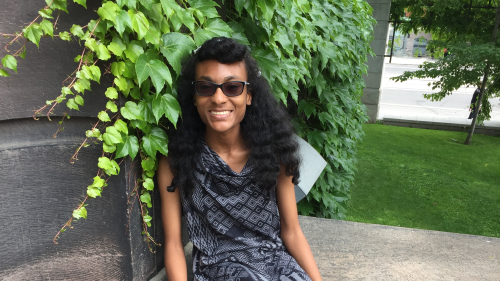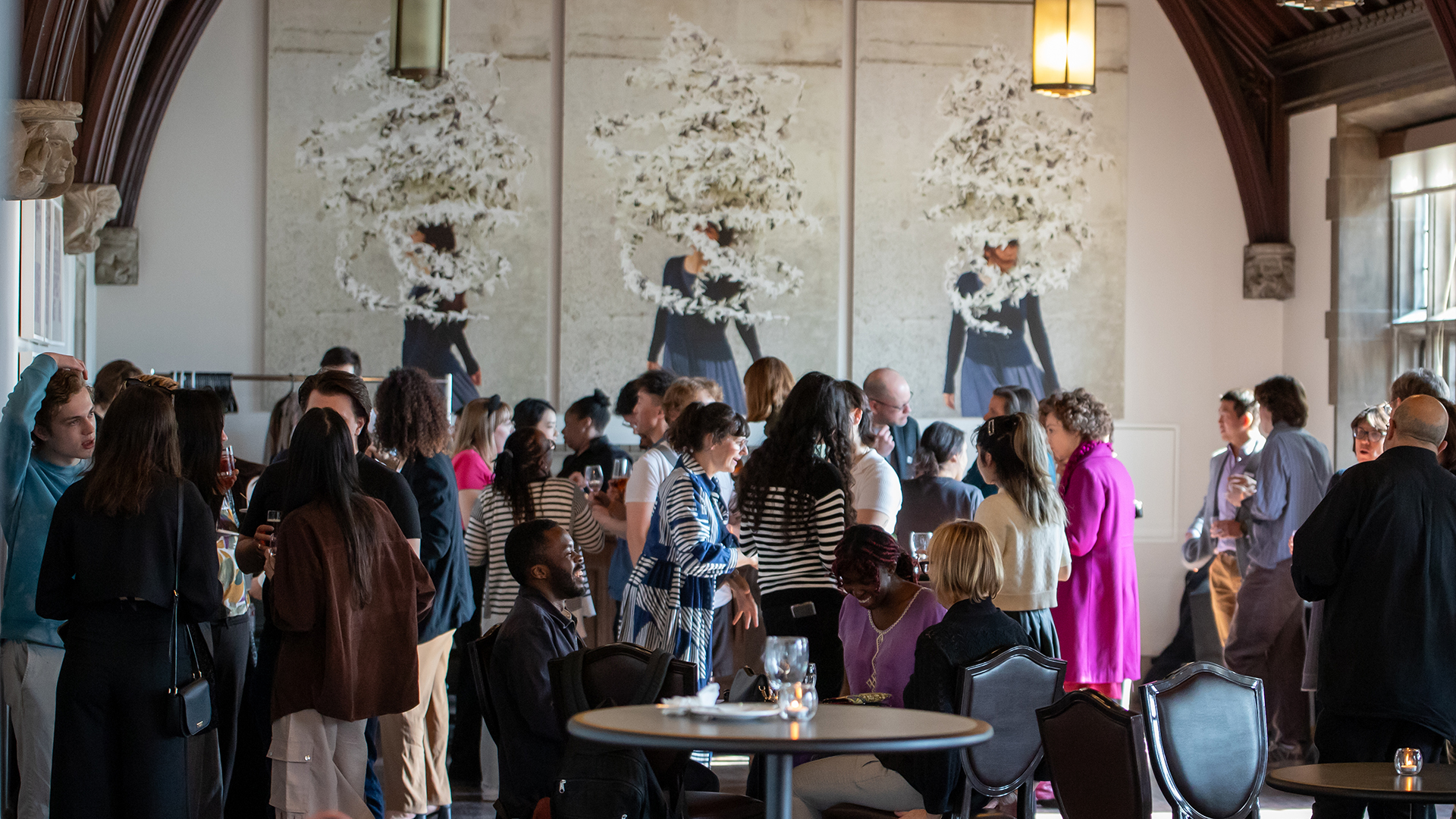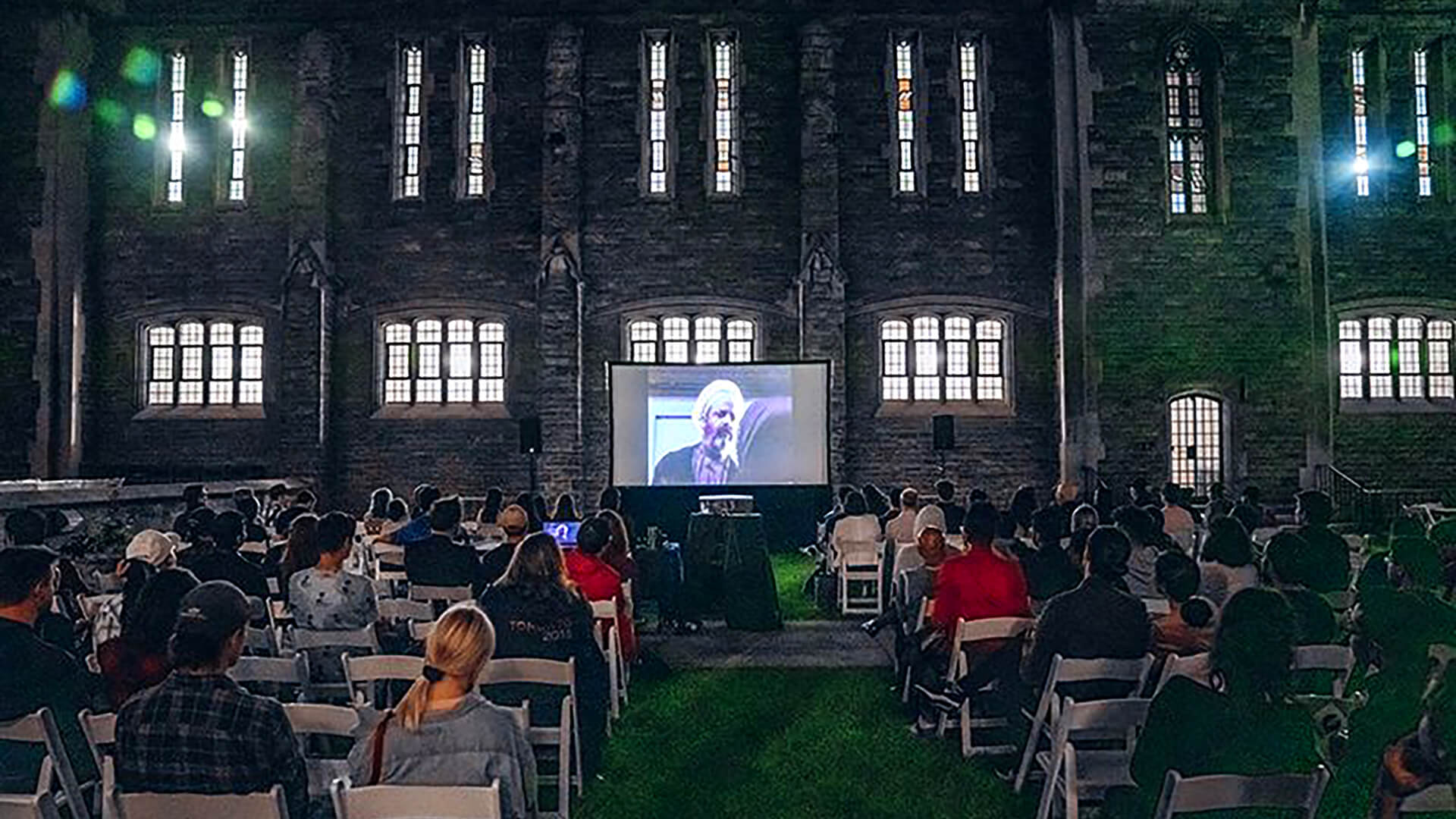
Currently on display at Hart House and accessible online, the Future of My Own project relays the stories of six U of T alumni who were the first in their family to attend university. Student Josanne Buchanan shares how she got involved in this exciting initiative that combines visual and audio storytelling.
Can you tell us what year and program of study you are in?
I am a second-year student who is currently pursuing a Psychology Specialist and a Visual Studies Minor.
How did you first learn of the Talking Walls project, and how did you get involved?
As I explored Hart House one afternoon last spring, I noticed a collection of panels that were displayed on two walls in one of the facility’s main hallways. I scanned the panels, walking the length of the hallway in order to read through the stories that were presented in the display. Through this investigation, I learned that the panels belonged to an initiative called the Talking Walls project.
Sometime later, I learned that the Talking Walls project team was looking for a Work-Study student who could plan, design, and co-facilitate a project that would be showcased during the following year. Having seen many Talking Walls projects by that point, both in-person and through my own research, I was very interested in contributing to the initiative. I applied for the position and was hired for the Summer 2018 Work-Study session.
What attracted you to the Talking Walls?
I was attracted to the Talking Walls initiative because of its emphasis on communicating meaningful stories in an accessible way.
A significant component of what makes Talking Walls such a unique initiative is that it brings meaningful (and sometimes difficult!) stories into a public space, while still retaining the integrity of the voices that inform the project. I was really enamoured with the idea that, through the project, anyone can read and feel a story without having to diverge from their normal routes of activity. The project is designed and positioned so that an individual can learn about an important topic while walking to a conference, jogging to the Hart House gym, or just stopping to rest for a while (much like I did when I discovered the project). Because the Talking Walls project is located in such a crucial corridor of activity, the themes that it communicates have the ability to directly impact immediate trains of thought or beliefs about the world. That impact is unique, and it offers a thrilling challenge for both content producers and viewers.
The thought of being able to contribute to students’ experiences through transmedia was also a very attractive component of the project for me.
What has your involvement with the Future of My Own project been so far?
As one of the Project Coordinators for the Talking Walls, Future of My Own (FOMO) project, I have been involved with the project from its conception to its final installation. Working alongside my fellow Project Coordinator, Jaime, I planned each stage of the project, recruited individuals who were willing to share their stories with us, collaborated with the Hart House podcast team to record interviews, presented the project’s mission to stakeholders within the university community, pitched ideas, created the panel designs, and planned the promotional materials that will help students to better engage with the FOMO project in-person and online.
So far, this is the only exhibition/podcast series that I’ve worked on, but I thoroughly enjoyed this process and I hope to be involved with more multimedia projects in the future.
Have you learned anything in so doing that you couldn’t have learned in your program? If so, what?
My work on the Talking Walls project has given me exposure to several learning opportunities that I would not have encountered in my programs of study. Most of these unique learning opportunities have revolved around the proper use of media tools and techniques. For example, as I worked with the podcast team, I learned how to structure and facilitate successful interviews for different genres of podcasts and how to use podcasting equipment.
I also learned how to convey a coherent narrative across different forms of media, how to effectively pitch and revise project ideas, and how to work with graphic design software.
These are all things that I would not expect to learn through my programs.
What part or element of your work in this project has been most pleasant and/or useful for you?
The most pleasant element of my work in this project has been listening to the stories of interviewees.
As I worked on the FOMO project, I met with several alumni who shared their stories about being university students. During these meetings, alumni spoke about how they overcame their struggles and fears to become the resilient, impactful professionals that they are today. This was by far the most pleasant and useful element of my work in the project because it gave me a sense of encouragement that I could use to inform my own journey.
The drive to share this encouragement with all students was a great motivating factor for the team and I as we worked on this project.
Do you do anything else at Hart House?
When I’m not visiting Hart House to work on the Future Of My Own project, I’m using its spaces to study, relax, and create. This is something that I did before my involvement with Talking Walls, and it is something that I still love to do.
My favourite room to relax in is the Map Room, which is nice during the summer months when the windows are wide open and the ivy comes in. It’s a great place to sit back and reflect on things. In fact, being in the Map Room is like going on an adventure: since the space also houses the university’s radio station, CIUT, I never know which guests may come in for a radio segment or which song I’ll hear.
Hart House’s library is also a wonderful spot to study in. It’s quiet, comfortable, and it looks like it belongs in a storybook.
Many of Hart House’s rooms and halls are used for conferences and annual career fairs (many of which are free to students!). I have attended a few of these since I came to U of T, and will continue to do so for as long as I am a student.
Let’s say you have a friend at U of T. A student who’s interested in some of Hart House’s programs, activities, or clubs, but she’s busy, so she hesitates to get involved. What would you say to her?
Hart House has a long history of providing unique extra-curricular experiences and events for students, which makes it an exciting community to be a part of. But as a busy student myself, I understand that it can sometimes be hard to think about fitting time in for Hart House’s activities. As cool as a committee looks, I often think, how can I fit in time to be an active member when I have so much to do?
Here’s an encouraging fact: Hart House has a plethora of meaningful, equally engaging programs and activities that all students can be a part of. You don’t need to make a long-term commitment to be a part of the Hart House community!
As a student, you can take advantage of monthly workshops, classes, and clubs that can help you to have fun, learn and focus on your personal well-being.
When I’m at Hart House, I always seem to walk past a cool workshop or class that is open to all students, and I’m tempted to walk right in.
I’m grateful for the fact that so many of Hart House’s programs were designed to accommodate students who may not be sure of their ability to consistently participate throughout the year. It means that students can maximize their university experience without getting overwhelmed.
It means that you can choose to show up to Chess Club one Friday evening, and then choose to stay home and study the next. You have the opportunity to make new friends and have fun while also focusing on your academic commitments.
If it interests you, choosing to get involved with even just one Hart House program that accommodates your schedule can introduce you to a new skill, a new beloved hobby, or new friends. You may not even need to completely modify your schedule!
You can look at Hart House’s current events online or on-campus, find something that piques your interest, and then head out to experience a new, fun aspect of campus life.



